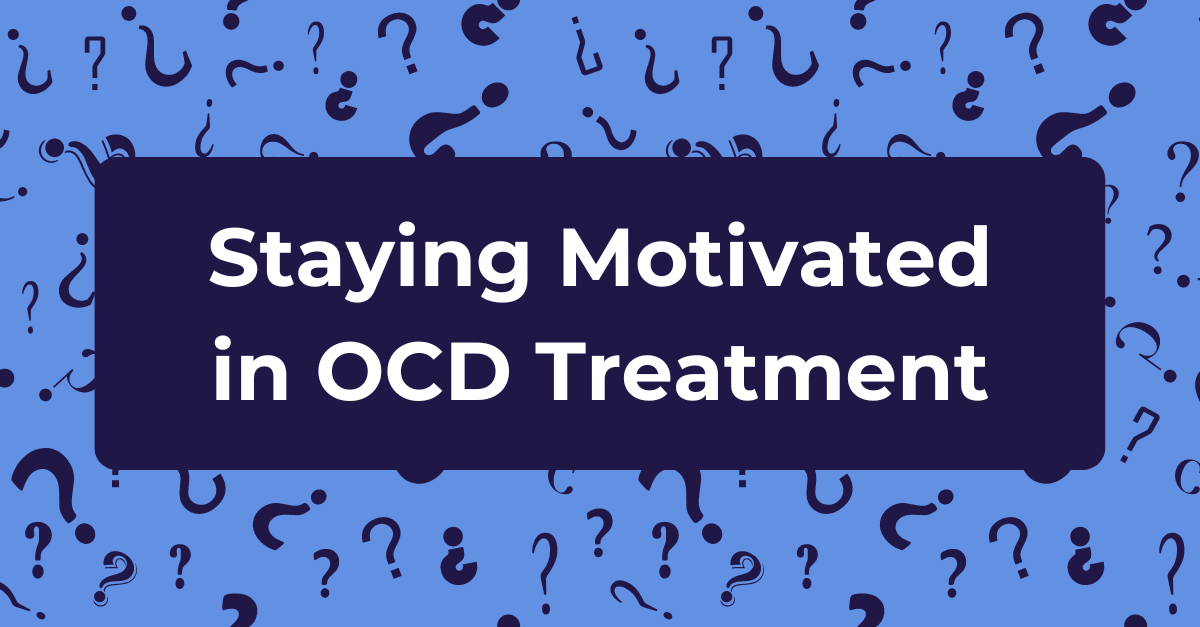October 12th, 2022

In observance of OCD Awareness week, October 9-15, it can be helpful to discuss how patients can stay motivated to challenge OCD symptoms.
McLean Hospital defines Obsessive Compulsive Disorder as, “A serious condition that can disrupt someone’s daily life. It is marked by obsessions or unwanted intrusive thoughts, and physical or mental actions taken to relieve anxiety associated with the obsessions.”
Individuals diagnosed with OCD can find themselves caught in what feel like endless cycles of unwanted obsessive thoughts and strong urges to engage in compulsive behaviors. It can be particularly discouraging if traditional talk therapy and coping techniques for anxiety are unsuccessful in preventing compulsions from taking over.
This article will outline two therapeutic techniques that can be more effective in managing symptoms of OCD: CBT (Cognitive Behavioral Therapy) and a CBT technique called ERP (Exposure and Response Prevention). If you have been diagnosed with OCD and are finding yourself struggling to stay motivated to engage in treatments, you may want to speak with your therapist about whether these techniques may be helpful for you.

Cognitive Behavioral Therapy helps an individual identify unhelpful thought and behavior patterns that contribute to cycles of increased anxiety and distress. There are several CBT practicesthat can be helpful in gaining control over OCD symptoms.
An individual may be encouraged by their therapist to engage in mindfulness practices, in order to increase their awareness of their thought processes as well as increase their ability to stay present and in the moment during times of increased emotional distress.
As the individual is able to increase their awareness and presence, they can start to work on practicing acceptance of their unwanted thoughts and distressing emotions. Individuals with OCD often use compulsive behaviors as a means to stop, or push away, obsessive thoughts. However, engaging in compulsive behaviors or trying to fight against or control one’s thoughts often just drives anxiety levels higher and increases emotional distress rather than providing relief. Practicing acceptance that anxious thoughts are there and that they are what they are, just thoughts, rather than fighting against them can actually be more effective in reducing anxiety.
So, does acceptance of unwanted thoughts mean that we just have to be okay with them? No! The next step in the process is assessment. Now that the individual has been able to recognize these thoughts, and is no longer fighting against them in unhelpful ways, they can work with their therapist on pinpointing cognitive distortions in their thought processes. Cognitive distortionsare thought patterns and beliefs that have a tendency to get in the way of making progress and can lead to increased anxiety and depression symptoms.
One may ask, “But what do I do about it?” now that they have increased awareness of these thought patterns. While simply having increased awareness of these thought and behavior patterns can be helpful in establishing more control over symptoms, there is one more vital step in this process: action! Action is defined as actively confronting the individual’s fears and anxieties while working to increase tolerance of the distress of doing so and managing compulsive behavior urges that are triggered. This is done with the assistance of a therapist through a CBT technique called Exposure and Response Prevention (ERP).

To better understand what ERP is, it can be helpful to break down what exactly these terms are referring to. The word “Exposure” means the individual will be exposed to “triggers”, or things that may provoke a person’s obsessive thoughts. These triggers can range from thoughts to objects to specific situations; anything that creates anxiety and elicits obsessive thoughts in the individual. “Response Prevention” is the individuals’ efforts to refrain from engaging in compulsive behaviors that can be triggered by obsessive thoughts.
The individual begins by working with their therapist to identify a hierarchy of anxiety triggers, from least to most distressing. The therapist can then help to develop a series of exposures for each trigger, and the individual commits to not engaging in the compulsive behavior when exposed to the trigger. Over time, anxiety decreases in the presence of the trigger and the individual no longer feels a strong urge to engage in the compulsive behavior. This is called “habituation”. The individual can work their way up the hierarchy that they identified, and eventually may even be able to engage in their own ERP without the guidance of their therapist.

While the strategies above are the most common and effective for treating OCD symptoms, there are other skills that can be helpful in managing the anxious thoughts that drive urges to engage in compulsive behaviors.
Managing symptoms of OCD can feel like an extremely difficult and exhausting process due to the intensity of the anxious, intrusive thoughts and the disruption to daily life that compulsive behaviors and rituals cause. Individuals may get discouraged and feel as though they are at the mercy of their thoughts and compulsions, but there is hope! The practical and therapeutic strategies described above can help individuals gain control over anxious thoughts and better manage compulsive behaviors.
Written by: Leslie Wolf, LCPC.
At Clarity Clinic, we have highly trained staff who specialize in therapy and psychiatry services. To learn more about how we can support your mental health, call Clarity Clinic at (312) 815-9660 or schedule an appointment today.
Our Services
Virtual/Online CarePHP and IOPAdult PsychiatryChild & Adolescent PsychiatryAdult TherapyChild & Adolescent TherapyCouples CounselingFamily TherapyGroup TherapyPsychological TestingTranscranial Magnetic Stimulation (TMS)